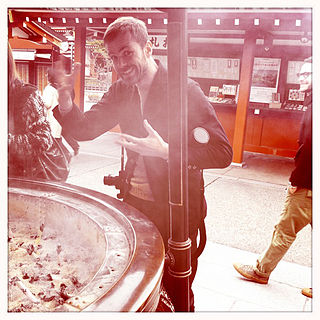
Martin Parr is a British documentary photographer, photojournalist and photobook collector. He is known for his photographic projects that take an intimate, satirical and anthropological look at aspects of modern life, in particular documenting the social classes of England, and more broadly the wealth of the Western world.

Alec Soth is an American photographer, based in Minneapolis. Soth makes "large-scale American projects" featuring the midwestern United States. New York Times art critic Hilarie M. Sheets wrote that he has made a "photographic career out of finding chemistry with strangers" and photographs "loners and dreamers". His work tends to focus on the "off-beat, hauntingly banal images of modern America" according to The Guardian art critic Hannah Booth. He is a member of Magnum Photos.
Mark Power is a British photographer. He is a member of Magnum Photos and Professor of Photography in The Faculty of Arts and Architecture at the University of Brighton. Power has been awarded the Terence Donovan Award and an Honorary Fellowship from the Royal Photographic Society.
Rinko Kawauchi HonFRPS is a Japanese photographer. Her work is characterized by a serene, poetic style, depicting the ordinary moments in life.

Derek Ridgers is a British photographer known for his photography of music, film and club/street culture. He has photographed people including James Brown, the Spice Girls, Clint Eastwood and Johnny Depp, as well as politicians, gangsters, artists, writers, fashion designers and sports people. Ridgers has also photographed British social scenes such as skinhead, fetish, club, punk and New Romantic.

Ewen Spencer is a British photographer and filmmaker based in Brighton, England. His photography is primarily of youth and subcultures.

Daniel Meadows is an English photographer turned maker of digital stories, and a teacher of photography turned teacher of participatory media.

Nigel Shafran is a photographer and artist. His work has been exhibited at Tate and the Victoria and Albert Museum. In the 1980s Shafran worked as a fashion photographer, before turning to fine art photography. Talking to The Guardian journalist Sarah Philips, Shafran described his work as, "a build-up of images, often in sequences. There is a connection between them all. Basically, I'm a one-trick pony: it's all life and death and that's it."

Joachim Schmid is a Berlin-based artist who has worked with found photography since the early 1980s.
Gordon MacDonald works with photography as an artist, writer, curator, press photographer and educator.
Brighton Photo Biennial (BPB), now known as Photoworks Festival, is a month-long festival of photography in Brighton, England, produced by Photoworks. The festival began in 2003 and is often held in October. It plays host to curated exhibitions across the city of Brighton and Hove in gallery and public spaces. Previous editions have been curated by Jeremy Millar (2003), Gilane Tawadros (2006), Julian Stallabrass (2008), Martin Parr (2010) and Photoworks (2012). Brighton Photo Biennial announced its merger with Photoworks in 2006 and in 2020 its name was changed to Photoworks Festival.
Photoworks is a UK development agency dedicated to photography, based in Brighton, England and founded in 1995. It commissions and publishes new photography and writing on photography; publishes the Photoworks Annual, a journal on photography and visual culture, tours Photoworks Presents, a live talks and events programme, and produces the Brighton Photo Biennial, the UK's largest international photography festival Brighton Photo Biennial,. It fosters new talent through the organisation of the Jerwood/Photoworks Awards in collaboration with the Jerwood Charitable Foundation.
Lisa Barnard is a documentary photographer, political artist, and a reader in photography at University of South Wales. She has published the books Chateau Despair (2012), Hyenas of the Battlefield, Machines in the Garden (2014) and The Canary and the Hammer (2019). Her work has been shown in a number of solo and group exhibitions and she is a recipient of the Albert Renger-Patzsch Award.
Archive of Modern Conflict (AMC) is an organisation and independent publisher based in Holland Park, London, England.

Self Publish, Be Happy (SPBH) is an organisation founded by Bruno Ceschel in 2010 that aims to help aspiring photographers to self-publish their own books. It does so through workshops, talks, exhibitions, live events, on/offline projects and publicising of books. It is based on Ridley Road, in Dalston, London, where it keeps a library of some 2000 donated self-published zines and books.
Clare Strand is a British conceptual photographer based in Brighton and Hove in the UK. She makes, as David Campany puts it, "black-and-white photographs that would be equally at home in an art gallery, the offices of a scientific institute, or the archive of a dark cult. ... They look like evidence, but of what we cannot know."
Patricia Anne "Tish" Murtha was a British social documentary photographer best known for documenting marginalised communities, social realism and working class life in Newcastle upon Tyne and the North East of England.
Jamie Hawkesworth is a British fashion and documentary photographer.
Sophie Gerrard is a Scottish documentary photographer whose work focuses on environmental and social themes. She is a lecturer at Edinburgh Napier University, a member of the board of trustees for Impressions Gallery in Bradford, and a co-founder member of Document Scotland. She has won the Jerwood Photography Award, the Fuji Film Bursary and the Magenta Foundation Award.
Marc Vallée is a British documentary photographer who has photographed youth culture, in Paris, Berlin, and London where he lives. He has made work about the tension between public and private space in the context of graffiti, skateboarding and queer cultures. Vallée has self-published many zines and shown in group exhibitions at the Museum of London and Somerset House.








